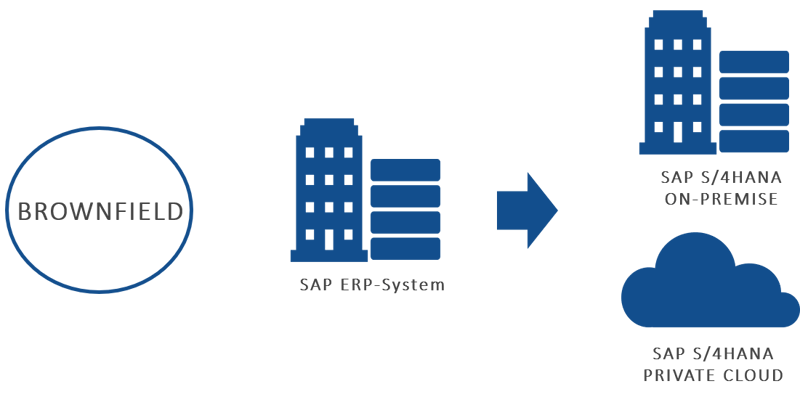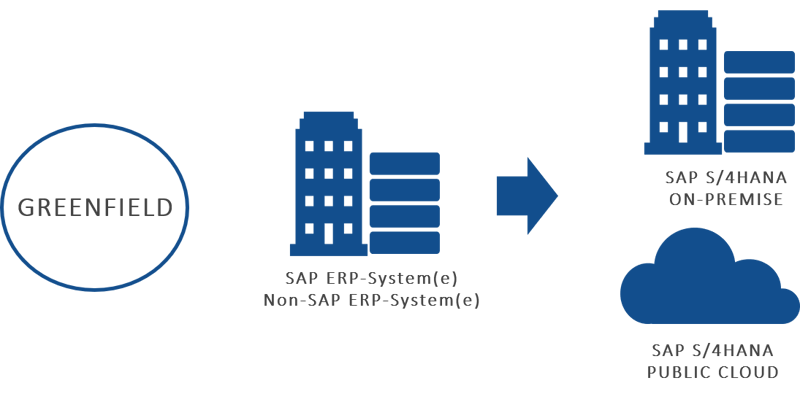SAP S/4HANA opens up completely new possibilities for companies: Among other things, they generate added value with the help of the Internet of Things (IoT) and benefit from real-time analytics. SAP S/4HANA integrates seamlessly with business networks and solutions from other software providers. The software forms the basis for making the right decisions at the right time. SAP S/4HANA is based on the SAP HANA in-memory platform and is available both on-premise and in the cloud.
Sooner or later, your company will also be faced with the task of successfully making the transition to SAP S/4 HANA. Unfortunately, many long-standing SAP ERP customers underestimate the challenges involved and the complexity of an SAP S/4HANA project.
How do I handle my custom code, i.e., custom developments?
How can I optimally manage my new SAP S/4HANA system landscape?
What downtimes should I expect during the final system changeover (go-live)?
How long will my code freeze (development stop) last before the changeover and what should I bear in mind?
What data must or should be cleaned up and archived as part of housekeeping?
What does my new role and authorization concept look like and how do I bring my users into the new system?
How do I ensure that my new SAP S/4HANA system meets current security requirements?
What (technical) requirements do I have to meet in order to convert?
Which transactions no longer exist in SAP S/4HANA and which will be replaced?
What does my SAP Fiori strategy look like?
How do I deal with my interfaces?

michelle.woerner@ibsolution.com
+49 7131 2711-3000
With our Transformation Assessment for SAP S/4HANA, you are optimally prepared for the targeted migration to SAP S/4HANA on-premise or SAP S/4HANA Cloud. We work with you to develop a fact-based decision-making basis for your successful ERP transformation, a customized roadmap and a recommendation for the subsequent implementation.
The brownfield approach refers to a system conversion in which the existing SAP ERP system is brought to SAP S/4HANA step by step. A detailed SAP S/4HANA roadmap shows the path to SAP S/4HANA in individual stages. Already defined processes and custom developments are technologically migrated in a first step and then adapted step-by-step to new requirements and innovative business ideas. The brownfield approach offers certain advantages compared to the greenfield variant (new implementation), for example, reduced complexity of the migration project and a significantly shorter project duration. These arguments are key reasons why SAP customers opt for the brownfield approach.

Since every company and system landscape has its individual characteristics and has grown historically, there is no patent recipe for a successful migration to SAP S/4HANA. But there are at least a few success factors that play an important role in the migration to SAP S/4HANA:
The basis of all migration projects is a clear objective that is supported by all departments involved, the national subsidiaries and the management.
Furthermore, it is advisable to build on the latest software version of SAP S/4HANA. This prevents the project from dragging on due to upgrades.
It is also important that the master data used is of high quality. Ideally, the standardization and harmonization of master data objects should already begin in parallel with the process design. This is because standardization can accelerate the migration. Speed is an important factor for project success.
Peripheral systems such as Supply Chain Management (SCM) or Customer Relationship Management (CRM) must be included, as shifts in functionalities may result.
Employees also play a crucial role. The acceptance of the changeover to SAP S/4HANA stands and falls with the speed of implementation. Therefore, agile ways of working and early piloting of Minimal Viable Products (MVPs) are crucial for success. Small concessions in localization or the adoption of legacy functions can win the hearts of employees.
PROFI Engineering Systems AG, a medium-sized IT solutions company based in Darmstadt, has successfully migrated to SAP S/4HANA. As implementation partner, IBsolution supported the system conversion in a brownfield approach, after the Heilbronn-based SAP consulting company had already introduced SAP Business Partner – a mandatory prerequisite for SAP S/4HANA – at PROFI in an earlier project.

With the brownfield approach, the setup of the new SAP S/4HANA environment is faster because the existing processes are largely adopted.
By adopting existing processes, the project scope and the risk of errors in the mapping of processes in the new system are reduced.

With a system conversion, as performed in the brownfield approach, the project effort and timeframe are easier to plan.

Step-by-step migration gently introduces users to SAP S/4HANA. This reduces the amount of training required and the associated costs.

Established processes and custom developments will continue to be operated in the first step of the changeover to SAP S/4HANA and will only be modernized gradually.
... you want to switch to SAP S/4HANA quickly and pragmatically.
... you want to create the technical basis for innovation.
... you want to introduce process innovation into your company in an iterative and agile manner.
With the greenfield approach, you start completely new with your ERP system on a “green field”, so to speak. While the system conversion (brownfield approach) transfers the existing systems and processes into the new world of SAP S/4HANA, the greenfield approach means a new implementation of systems and processes. Complete re-engineering offers you the chance to redefine and simplify your processes. The SAP standard and SAP best practices serve as starting points. Customer-specific developments often become obsolete with the introduction of SAP S/4HANA, as many functions are already mapped by the SAP standard. In this context, it makes sense to also re-evaluate surrounding systems and replace them if necessary.
In addition to the classic on-premise approach, a greenfield implementation also offers the option of implementing SAP S/4HANA in the cloud. Companies benefit above all from a low total cost of ownership (TCO) and the flexible scalability of their SAP systems. In addition, due to SAP’s cloud-first strategy, the latest innovations that SAP delivers as part of regular updates are first available to companies that obtain SAP S/4HANA from the cloud.

Implementing SAP S/4HANA is not just a technical upgrade of your existing ERP system. As an intelligent business suite, SAP S/4HANA forms the basis for forward-looking innovations and represents an important step towards the intelligent enterprise.
With a greenfield implementation, you invest in the digitization of your company while optimizing existing processes and streamlining your IT system landscape.
The greenfield approach gives you the chance to rethink and optimize your existing processes. Adopt only those processes and functions that you really still need.
You continue to use your current ERP system while the new implementation of SAP S/4HANA takes place on a separate system.
As part of a new implementation, it pays to clean up master data. Migrate only the data to SAP S/4HANA that you really need and leave legacy data behind.
With a greenfield implementation, you streamline your IT system landscape and return to the SAP standard. This increases flexibility while reducing operating costs.
Implement SAP S/4HANA in the cloud and always benefit from the latest innovations.
... you want to streamline your existing system landscape.
... you want to return to the SAP standard.
... you want to use SAP S/4HANA in the cloud.
The options for switching to SAP S/4HANA are as diverse as the SAP user companies. Many SAP customers have not just one, but several SAP ERP systems in use. SAP S/4HANA offers the possibility of merging the individual systems into a uniform system. Often, certain parts of the existing data are to be retained after the changeover to SAP S/4HANA, while other data is not to be taken along.
Requirements of this type are addressed by the greyfield approach, in which the existing landscape is renewed and streamlined (analogous to the greenfield approach), but existing data is partially transferred (see brownfield approach). Greyfield thus represents a mixture of a new implementation and a system conversion.
With the combination of greenfield and brownfield, companies benefit from advantages such as system streamlining and standardization. At the same time, they do not have to part with all their existing data if they do not see any advantages in doing so.

Are you still unsure whether you want to implement SAP S/4HANA as a greenfield or brownfield approach? Is deploying the ERP suite in the cloud perhaps the right path for you? We will clarify these and many other questions together with you in our Strategy Workshop for SAP S/4HANA.

You have decided to introduce SAP S/4HANA in a brownfield approach, i.e. in the form of a system conversion? In our one-day workshop, we work with you to develop an individual roadmap for your SAP S/4HANA conversion and also look at all the necessary preliminary work.

In the course of a migration to SAP S/4HANA, it is mandatory to switch to the SAP Business Partner data model. With our three consulting packages, you get this conversion at a fixed price − tailored to your specific requirements. Harmonize customers and suppliers under SAP Business Partner.

In SAP S/4HANA, there is only one journal table based on SAP New General Ledger. For this reason, you should already introduce the New GL before the migration. Use our migration package to introduce SAP New General Ledger at a fixed price.

Do you want to reduce financial risks by optimizing your receivables and credit management? Or are you about to implement SAP S/4HANA, which requires SAP Credit Management? In both cases, we offer to implement SAP Credit Management at a fixed price.
Our add-on INCEMENDO.data_access provides OData services for SAP ECC to enable communication between the standard ERP and SAP Business Technology Platform. This makes your customer-specific developments compatible with SAP S/4HANA even before the actual migration, so that the subsequent changeover can be made without risk and without additional effort.
Simply complete the form and submit it. We will get back to you as soon as possible.